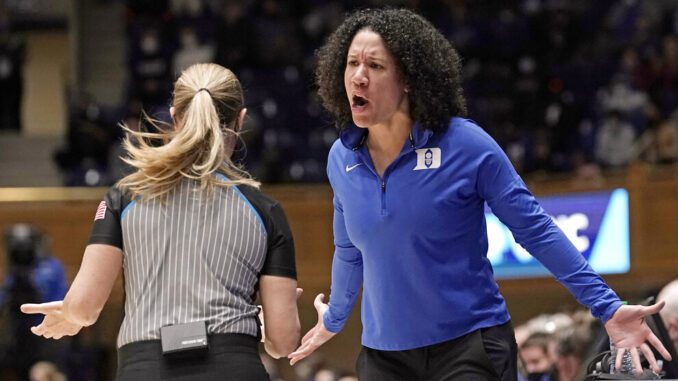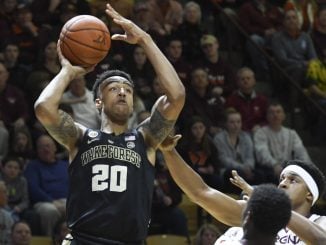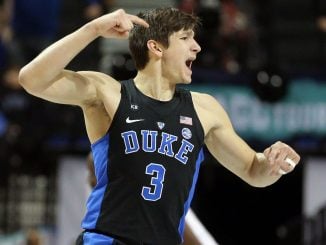
The ACC has heralded itself as the gold standard of college basketball since its inception in 1953.
And it remains that way today. Only not in the traditional sense.
While the conference has slipped in both stature and the quality of its product on the men’s side over the past few years, its women’s teams have stepped up to carry on the tradition of being the nation’s best, most competitive league.
There are currently six ACC teams ranked in The Associated Press women’s basketball poll, with Louisville and NC State among the top five. Duke, UNC, Notre Dame and Georgia Tech are the others.
Thursday’s sold-out game at Reynolds Coliseum between the fifth-ranked Wolfpack and the No. 24 Tar Heels — one of only four remaining unbeaten teams nationally — will be the first of many matchups between ranked ACC women’s teams this season.
As of today, there won’t be any such showdowns on the men’s side, not even the two highly anticipated clashes between UNC and Duke.
Why?
Because other than the second-ranked Blue Devils, not even one of the ACC’s 14 other men’s teams received so much as a vote in this week’s poll,
“I kind of joke with people that we are a women’s basketball league,” former Clemson star and ACC Network analyst Kelly Gramlich said.
“Don’t get me wrong, the men can still get back. But the way things are with the women right now, it reminds me of the way the men used to be — with North Carolina-Duke, super-elite, with three or four others capable of making a (deep NCAA Tournament) run. If you look at the conference top to bottom, there’s just so much talent there.”
That’s not an exaggeration.
Eight of the league’s top 10 scorers in 2020-21 are back, as are 11 of the 15 selections to the three All-ACC teams after many of the top players — including NC State starters Kayla Jones, Raina Perez and Kai Crutchfield — chose to use the extra year of eligibility granted to them because of the COVID pandemic rather than finishing their schooling or turning pro.
And the rich only got richer thanks to the NCAA’s transfer portal and relaxed rules that allow players to suit up for their new schools without having to sit out a year.
The quality and depth of the conference are evidenced by the league’s 120-38 overall record through Jan. 1, a winning percentage of .759. That includes 10 wins against ranked opponents and five against the top five.
Six different teams have beaten at least one ranked nonconference opponent.
“I don’t sleep on any team,” Wolfpack forward Jones said. “You can think about Louisville and NC State, but every school in the ACC is really tough.”
Louisville coach Jeff Walz takes it a step further.
“As a conference, I think we can have four or five teams as top-four (NCAA) seeds,” he said, adding that he doesn’t see anyone making it through the league regular season unbeaten, let alone with only one or even two losses.
“I’m not talking five or six teams in the NCAA Tournament; I’m talking about five or six as top-four seeds and there’s only 16 of them. That just shows how strong our entire league is.”
It used to be that way with the men. And not just during the golden era of ACC basketball before the conference expanded from nine to 15 members in the early 2000s.
As recently as 2019, the league earned three of the four No. 1 NCAA Tournament seeds with seven teams receiving bids. One of them, Virginia, went on to win the national championship.
The drop-off since, however, has been dramatic.
Although the 2020 postseason was canceled because of the pandemic, the ACC dropped to No. 4 among conferences nationally in the respected KenPom rankings. It dipped another notch to No. 5 in 2021.
As was the case two seasons earlier, seven league teams were included in the NCAA’s field of 68. The difference in 2021 was that none of them were seeded higher than fourth, and not one made it past the Sweet 16.
It was a performance dismissed by most around the conference as a hiccup caused either directly or indirectly by COVID and the loss of many top players to the NBA. In contrast to the women’s side, only four of the 10 men’s scorers and four of 15 All-ACC selections returned to their teams.
But things haven’t gotten any better this season. In fact — except for a rejuvenated Duke bolstered by an infusion of new talent and inspired by coach Mike Krzyzewski’s swan song — they have been worse.
Not only did the conference lose the annual ACC/Big Ten Challenge for the third straight year — and eighth time since 2009 — but it has gone a combined 18-36 in head-to-head matchups with the other Power 5 leagues and the Atlantic-10.
Already this season, ACC teams have lost to the likes of Albany, The Citadel, Wright State, Navy, Colgate, Monmouth and James Madison.
“The ACC was a bit down last year. I’m not going to sit here and act like it was great,” Virginia coach Tony Bennett said at the league’s preseason media event last October. “But let me say that a down year in the ACC is still really good. There was still some quality play in it.
“Maybe there’s some parity that’s coming over college basketball. It’s getting harder to establish dynasties and maybe even dominant conferences because of transfers and early departures. That makes it challenging, but it’s still a basketball league, still a great league.”
He’s right about that. It’s still a great basketball league.
Back when James Brown sang it’s a man’s world, it accurately applied to ACC basketball. But the current league would be nothing without the women.



